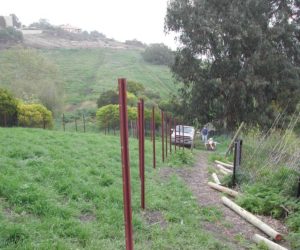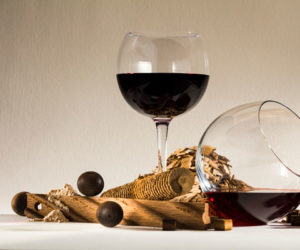Oxidation in a white wine is generally the stuff of winemakers’ nightmares. At best, the wine can be browned and nutty, with diminished fruit aromas. At worst, it can smell like nail polish remover or vinegar. Most winemakers go to great lengths to prevent oxidation, especially on more delicate white wines. Some brave winemakers, however, take an entirely different approach and use a process known as “hyperoxidation.” If you are somewhere between curious and alarmed at the thought of extreme oxidation to these poor, helpless white wines, you are not alone. Who in their right mind would intentionally oxidize a wine to the point of browning? And can this be a good thing? Those are the questions we’re going to answer in this article.
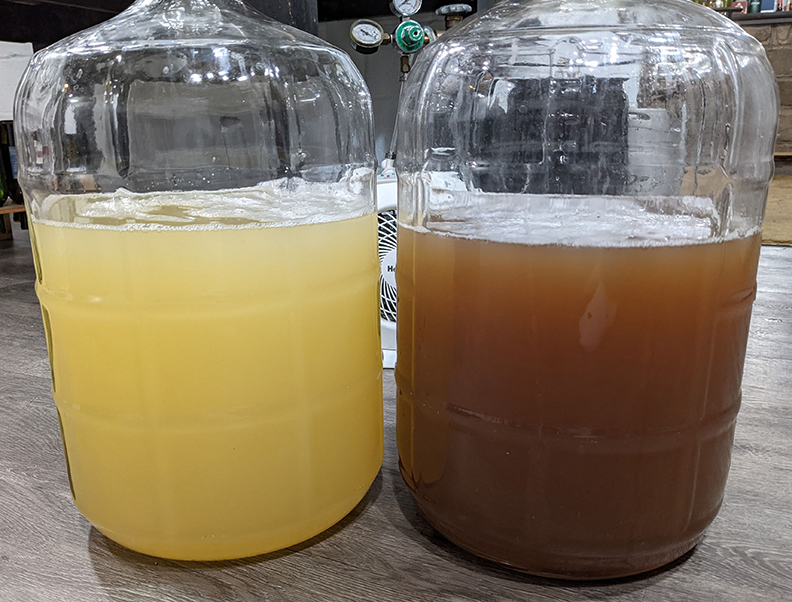
Right: A carboy of pressed white juice that has undergone hyperoxidation prior to pitching yeast.
Why We Don’t Normally Like Oxidation
Before we get into hyperoxidation, you need to have an understanding of what oxidation is and why it is generally considered to be so detrimental to wine. Oxidation of a wine is usually a microbial process involving air- hungry spoilage bacteria or spoilage yeast. This is the damaging oxidation that we try to prevent. The microbes don’t necessarily come from contaminated equipment, but instead can ride in on the grapes as they leave the vineyard, which complicates things for the winemaker.
The meal of choice for these oxidative organisms is typically ethanol, which is converted to acetaldehyde and further oxidized into acetic acid (vinegar). The now present acetic acid can be esterified with any free ethanol molecules to form ethyl acetate, which is the common nail polish remover smell you get in a poorly made wine. While this type of oxidation is scary, it is also easily preventable with proper SO2, acid, and oxygen management.
A milder but still damaging form of oxidation can occur slowly in the bottle. Over time, phenols will chemically break down, causing a white wine to shift to more of a copper color. Phenols come from the skins and seeds of most fruits, including grapes. They include things like tannin, anthocyanin (red pigment), flavonoid phenols (flavonols), and phenolic acids. The breakdown of flavonoid phenols in particular can cause an increase in astringency and this copper shift. If subtle enough, this may be perceived as “complexity,” but as this chemical breakdown progresses the wine quality and aroma will deteriorate.
With the rise of mechanical grape harvesting, white juices can have a high enough flavonol content to exaggerate this problem. Ideally most white grapes will be pressed as whole berries, or crushed and pressed with a very brief and controlled skin contact time, limiting extraction from the seeds and skins. If grapes pop in the field during mechanical harvesting, the extraction can start before they even make it to the winery. So how can we deal with a juice that may have already been over-extracted?
Hyperoxidation to the Rescue
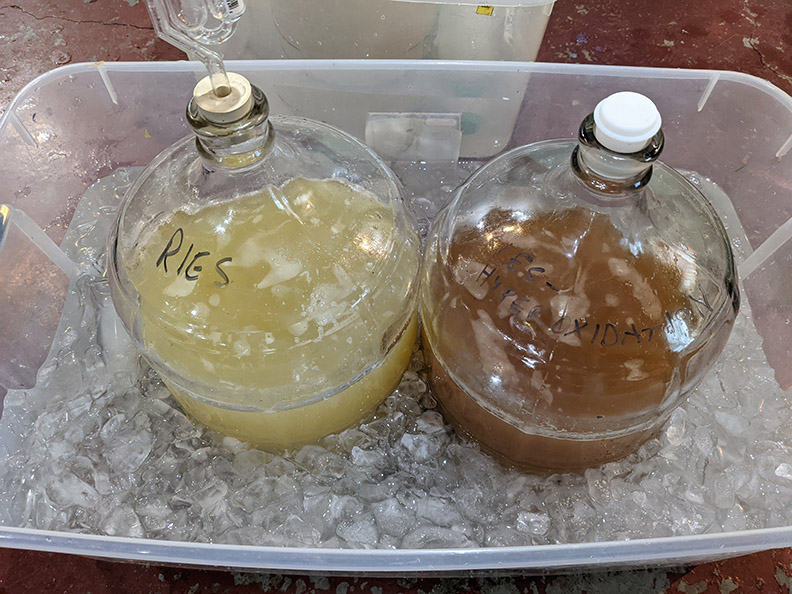
White winemakers will almost always take steps to assure that the juice does not oxidize before fermentation. This includes adding sulfites at the crusher and minimizing oxygen contact as the juice is clarified or cold settled.
More recently, some wineries have been experimenting with a process called hyperoxidation with the aim to reduce phenol content. Simply put, this is the process of pressing the white grapes, introducing oxygen to the juice until it browns, clarifying, and then beginning the fermentation. The browning of this fresh juice is enzymatic and kicked off by a class of enzymes called polyphenol oxidases (PPOs). While this browning can be terrifying to even the most experienced winemakers, the color is only temporary.
Enzymes are in the protein family and act as a catalyst to speed up a chemical reaction. They are most effective before fermentation, when alcohol is not present. In the case of PPOs, the enzymes will encourage a rapid oxidation of phenols. These phenols are degraded into insoluble brown pigment. The wine literally will turn brown — like chocolate milk (as shown at right in the image above next to a carboy of the same juice that has not been hyperoxidized). I have found that a small-batch white wine will begin to brown within about 30 minutes to an hour of pressing if sulfite is not added. You can expect this to take longer on large batches.
A word of caution: Not all enzymes are good. If more than a few clusters have visible Botrytis (noble rot), then hyperoxidation should not be attempted, as they will contain the enzyme laccase. Laccase can cause an irreversible browning and is more difficult to manage.
Some of this newly formed brown pigment (oxidized phenols) is separated during the cold settling or pre-fermentation clarification process. Even with clarification, though, the juice will remain very brown in color. It is not important to remove all of this pigment before fermentation but a reasonable attempt should be made to remove much of the solids. I always cold settle my white juice before fermentation and rack off of what has settled out. In the case of hyperoxidation, the settling can occur in conjunction with the oxidative browning process.
When the wine has browned to the desired level, alcoholic fermentation should be quickly started with a reliable yeast strain. My favorite yeast for white wines is Renaissance Fresco, as it creates a fantastic bouquet of fruity esters when fermented cold and will not create hydrogen sulfide (H2S). A close second is Sensy from Lalvin, which is also in the low-to-no H2S family. To ensure that things get moving quickly, hydrate about 1.5–2 grams of your preferred yeast per gallon (4 L) of juice. Once things are visibly bubbling in your starter, add an equal amount of juice and let it go for another 20 minutes. Make sure your yeast starter is within 10 °F (5 °C) of your juice, which should now be warmed briefly to about 70 °F (21 °C) to facilitate a rapid start to fermentation.
Note: Fresh-pressed white grapes can be very acidic, which can cause a fermentation to struggle. If your pH is below 2.95, adjust with potassium bicarbonate.
As the fermentation gets going, yeast will consume as much oxygen as they can get, bringing the wine to that happy middle ground between oxidative and reductive. You should see a gradual shift in color as yeast cells metabolize the remaining brown pigment. I generally like to stir my white wine fermentations once a day to bring any settled yeast back into suspension and keep settled yeast from becoming air starved. I suspect that this stirring also helps speed up the metabolism of brown pigment. By the time about ½ to ¾ of the sugars have been consumed, most of the browning should be gone, allowing you to sleep better at night.
After fermentation, the wine is visually similar if not identical to a traditionally fermented white, but much lower in phenols. In theory, this should allow subtle varietal flavors to shine through and will resist browning in the bottle, since phenols are the primary component that will brown. In some cases, a hyperoxidized wine can be bottled with less SO2, but keep in mind that most white wines will need sufficient SO2 to prevent malolactic fermentation if you are going for a crisp, fruit-forward style.
Real World Feedback on HyperOxidation
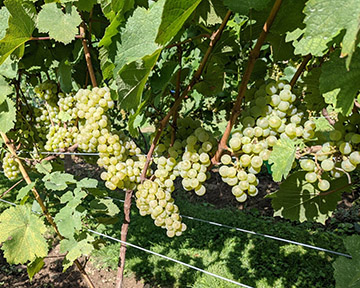
I have experimented with hyperoxidation on several white grape varietals from my small backyard vineyard and have been extremely happy with the resulting wines. But were the wines really better than a wine that was fermented without hyperoxidation? More recently, I set out to find an answer to this question. On a cold morning in September I rounded up my grape picking crew (some wine-loving colleagues) and we harvested a row of Riesling that was ready to be picked.
The grapes came off the vines nice and cold and were divided into two batches and crushed to yield approximately 4 gallons (15 L) of must each. The only difference in how the two batches were treated is one was sulfited at the crusher and one was not. They were pressed with a basket press, which is a relatively aerobic process so the juice was exposed to plenty of oxygen. Right off the basket press differences were starting to become evident as the unsulfited batch began to brown almost immediately. As expected, the sulfited Riesling maintained its greenish yellow color with no browning whatsoever. I would normally cold settle white wine for about 24 hours in an ice bath, but with the rate of browning being so aggressive, I halted the cold settle on both at 10 hours. There was some air space left in the carboys, which is necessary for fermentation but also helpful in this case of hyperoxidizing. By the end of cold settling, the difference in the two carboys was dramatic. I found this process to work well on the small home volume of juice that I was working with. In a much larger volume, like at a winery, it is more common to bubble air or oxygen through the wine to hyperoxidize it.
Both juices began at 20.5 °Brix, a pH of 3.00 and a TA of 9.3 g/L, which is not unusual for a crisp, refreshing Riesling. The yeast I used was Renaissance Fresco for reasons mentioned earlier. The oxidized juice started fermenting almost immediately, while the sulfited juice lagged for about 36 hours before it really woke up.
At 19 °Brix, the carboys were moved to a water bin where I would swap out “ice bombs” (bottles of frozen water) daily to maintain a fermentation temperature of about 60 °F (16 °F). Once a day, I swirled the wines briefly while removing the airlock. Because I was using a yeast that won’t produce hydrogen sulfide, I could get away with very little air supplementation during the fermentation.
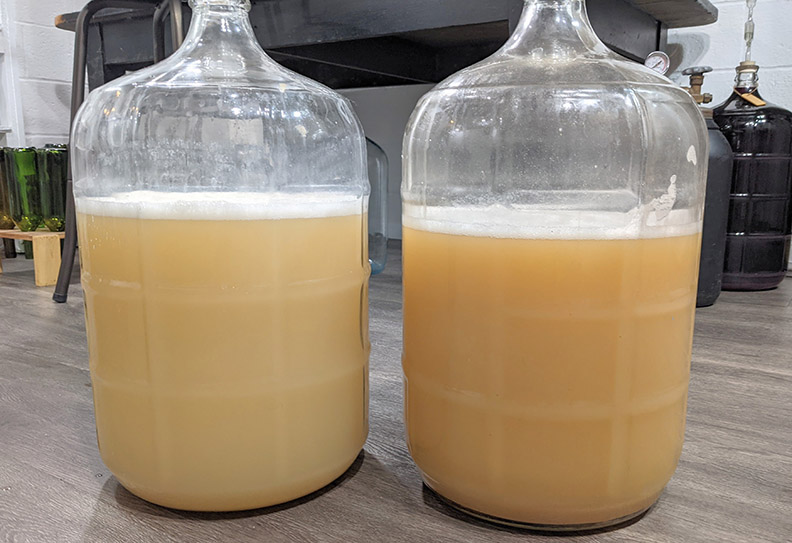
By day six of the fermentation (pictured above), most of the brown color was gone and both wines looked similar. Fermentation was complete after about 16 days for both batches. I stirred the lees for another four days, let the gross lees settle and racked into appropriately sized carboys. I was looking for a lively, crisp, and fruit-forward wine, so I sulfited at this time to prevent malolactic fermentation and moved the wines to the cold cellar to undergo cold stabilization.
Note: Rather than periodically adjusting SO2 levels, I prefer to add a larger dose after fermentation is complete. Normally the larger dose will be adequate and no further adjustments will be needed at the time of bottling. This method is more effective at preventing MLF, as it assures that you will not accidentally let the levels dip to an unsafe level as the wine ages. Alternatively, MLF can be prevented by removal of the bacteria through sterile filtration (very difficult without winery-grade equipment) or the addition of lysozyme.
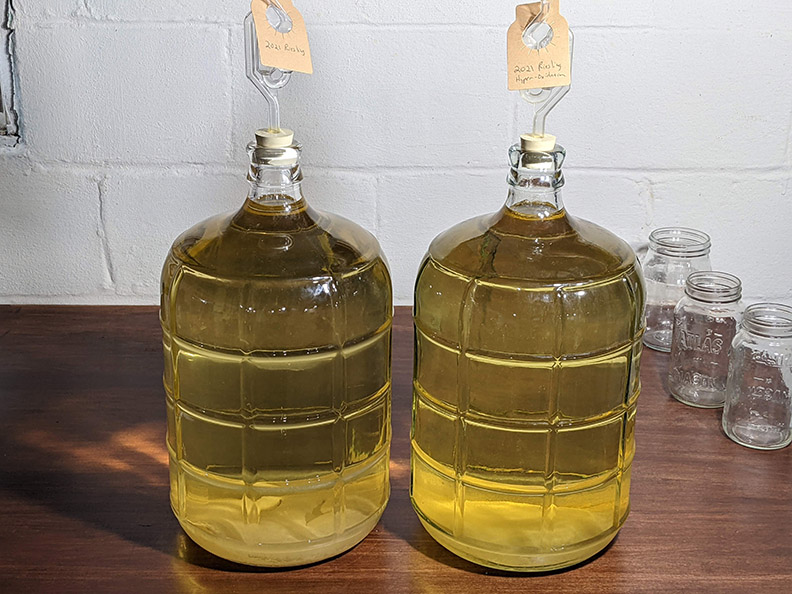
The Results
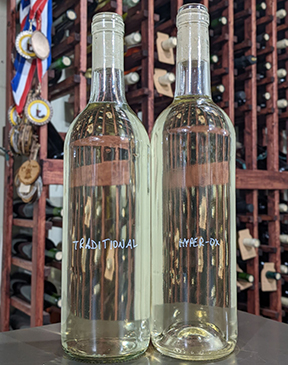
At three months, we tasted both of the young wines side-by-side while some friends were over. Three of four tasters preferred the hyperoxidized wine, noting that it was slightly smoother mid-palate. Both wines shared similar aromas of lemon zest, green apple, and citrus with some floral notes. The aromas in the hyperoxidized wine were about 80% as intense as the traditionally fermented wine at this stage (according to our non-scientific noses).
After four months in the carboy, the wines were crystal clear and could be bottled. By this time, the two wines looked visually identical. Both wines were on track to be stunners by summertime but could use just a little residual sugar to provide balance, so 7.5 g/L was added to each. This was just enough to moderate the acids, but not enough to add any perceptible sweetness.
After another month of bottle age, I was in search of some more skilled tasters to try these wines side-by-side so I reached out to Greendance Winery in Mount Pleasant, Pennsylvania. At Greendance, we gathered a group of wine enthusiasts including the owners, Rick and Susan Lynn. The wines were presented side-by-side in a double-blind format. Both wine labels were covered and even I didn’t know which was which. In total, we had six tasters.
Both wines received high ratings and were notably different, but the actual preference came down to the individual taster. Three participants preferred the hyperoxidized Riesling noting that it was more interesting on the palate and “more lively,” while three preferred the traditionally fermented Riesling that received sulfite at the crusher, noting that it had more taste in the mid-palate and a longer finish. The traditionally fermented wine ranked slightly higher on aroma with several participants noting an increased intensity. Common descriptors for both wines included citrus, grapefruit, green apple, and apricot. The hyperoxidized Riesling also had notes of mango, pineapple, and a hint of white pepper as described by one taster, which were not descriptors seen in the traditionally fermented variant. The traditionally fermented Riesling, on the other hand, had unique descriptors like “floral” and “pear.”
Based on this small study, there was no obvious winner, but every taster commented that there were definitely differences between the two wines, which may be reason enough for hobbyists to try the technique at home.
There are some reasons why this test may have had a split preference. The grapes were hand-picked and gently processed with a basket press, so there may not have been an appreciable amount of phenols in either wine after pressing. Both wines contained just enough sugar (0.75%) to “take the edge off,” but some of that rough edge may have been specifically caused by phenols. A bone dry tasting, like the informal at-home tasting we had done, may show more obvious preference towards the hyperoxidized wine. These wines are still very young, and the differences will likely become more evident as they get some bottle age and phenols begin to break down. Each wine taster has different ideals and some may be looking for a little edge on their white wine, which can also factor into a winemaker’s choice of approach.
Conclusion
It all sounds simple enough, but hyperoxidation is still a fringe technique, and for good reason. To most winemakers, including myself, it can be very unsettling to watch the grapes that you have nurtured all year oxidize so dramatically. If your grapes are over extracted from rough harvesting equipment or a warm harvest, the case is stronger for implementing the technique as a means to reduce bitter phenols.
In a year where I would have a large quantity of the same white grape, I may consider splitting off a batch and hyperoxidizing just to have more variety in the wine cellar. If nothing else, it makes for a very interesting story when you are serving the wine to other wine geeks.



